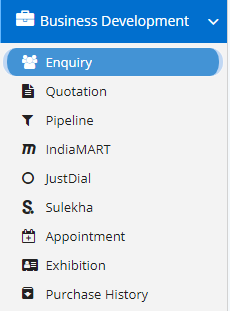
Enquiry is also known as Leads. Enquiries are later converted as a customer when you successfully sale the product and close the deal. Enquiries are considered as your first step towards to acquiring a customer and finally improving your business over the time. Enough of intro let’s get in the Enquiry module. This module is a part of Business Development Module and this can be accessed via Business Development–> Enquiry.
Following is the structure how Enquiry Module is inter-linked with other modules.

Following the Enquiry Grid which will list all of your Enquiries.

The top with button shows few elements like Search, New Enquiry, Refresh and Column Selector (will describe later in the chapter).
- Search Text box is used to search a specify or similar users form the list below. When you start entering characters it will start searching within the Enquiry Module.
- Refresh Button is used to reload the Enquiry Grid or Table so that the changes which are made to any user will be reflected on the grid.
- Column Selector is used to select one or multiple columns from the range of columns. Following is the image for the Column selector. Note – The columns shown in the filter will keep on changing as and when Nafhaa Platform makes changes to the module.

- The next two buttons are for downloading the Enquiry Grid as Excel or a PDF. These files will contain all the columns are which are visible in Enquiry Grid.
- The next button is for MailChimp using which you run marketing promotions using MailChimp Platform. More detailed explanation will in the Chapter named MailChimp. For more information, you can check with MailChimp portal – https://mailchimp.com/
- The next button is for Bulk SMS which is used to send promotional SMS to the selected customers. To select the customers via Enquiry, we have given a checkbox to select the same. There might be some keywords included which we expect the user not to remove those. Now, the question arises “What are keywords and how to identify them?” Keywords are those which start with # for example – #customername. But when you send SMS the keywords will be replace with appropriate values. Following is the dialog which will appear where you can add the details for SMS.

- The next button will show you the Filters. There will be a question in the mind of the readers, where are the filters? Yes, they are present and they been kept hidden because there are too many filters provided to filter out the records which you want to see. You have to click Show Filters buttons to reveal the filters supported by Enquiry Module. Using these filters, you filter the Enquiry Records and view only which are required. Filters with drop-down feature for the fields like Contacts, Status, Closing Type etc are few to name. On the other hand, fields which deals with Dates are given two fields as a part of Date range selection. You can use these filters in combination to filter the records.

- The next button under this section is the settings button which will invoke a new dialog showing the Enquiry Template Module. This button will be visible only if, the user has the permission.
- The next we have a button called as Detailed view, which will display all the product in a separate view including all the enquiries.

- The next button is the Bulk-Delete button which is visible only when permission is granted. Please use this feature very cautiously as it is irreversible process.
- Next button is a full-screen button, which will put the Enquiry page into full-screen mode for better viewing.
- The last two buttons are clearing the Preferences, which deals with the Column positions, their widths, etc which can be cleared by clicking the button and this will reset you Enquiry Grid, post which you will need to refresh the page. Finally, settings button, it will be visible only if the permission is granted. This button will invoke Enquiry Settings page where you can update module specific settings.
- In enquiry grid one option present to import data from FaceBook campaign lead generation. When user clicks to FaceBook icon following screen will display.

When some enquiries(Leads) came from facebook campaign program, it can be directly imported using this screen. Facebook generates the lead data with specific time intervals (Monthwise , weekwise etc.) So that excel can be used for import. the field representative is given to choose the users of system to whom enquiries will get assigned by default. The userwise assignment of enquiries done using following formula:
Enquiries assigned to Single User= No. Of Enquiries / No. of representatives selected.
If the No. of enquires and No. of representatives are not in proportions, then remaining enquires added to last users. Lets see this by example.
If no. of users=3, No. of enquiries=15, then each user will assign 15/3=5 enquiries.
If no. of users=3 No. of enquiries=17, then first 2 users will assign 5 and last user will assign 7.
This sums up the Enquiry Grid or Listing page. Now, lets go inside the module for better understanding.
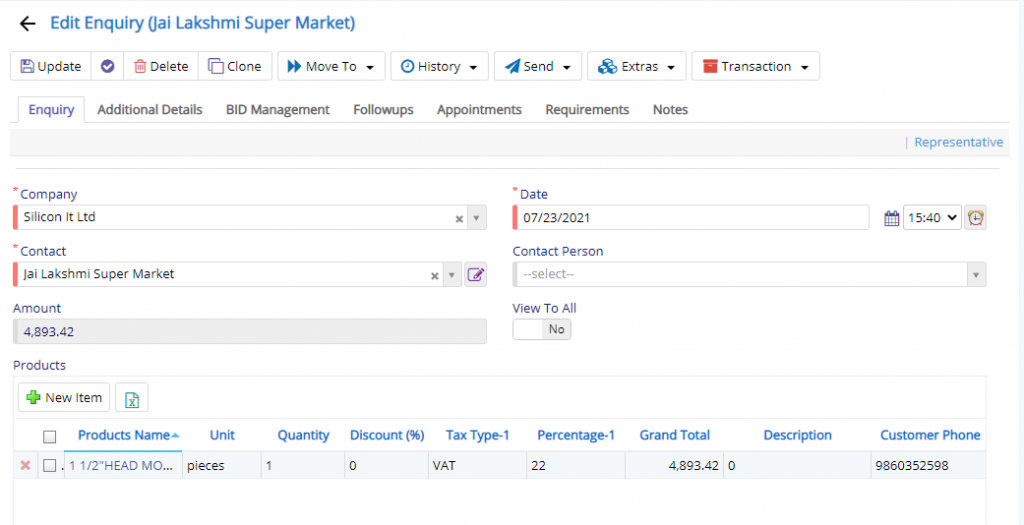
We can see lots of buttons on the top and each of them have specific operation defined for them to perform. These buttons will vary based on the modules opted by use during deployment of your portal and based on the settings you have enabled in Enquiry Settings tab.
- Starting from the left is the Update button which is used to update the changes that you have performed in any of the Tab. This button will change to Save when you are creating a new Entry.
- The Next button which is similar to Update button but the only difference is that, it performs the Update operation and remains on the same page. But the later Updates or Save and returns to the Grid displaying List of users. This button will change its meaning when you are creating a new entry. It will be called as Apply changes.
- The Next button is for Delete, this will delete the selected record from the database.
- Clone button will clone the currently opened record so that you don’t have to fill all the fields again thereby reducing your work of doing data-entry. But, this button is permission based and will appear only if the user has the permission to perform that action.
- Each buttons will explained in details from here onwards.

Move to buttons will have numerous operations and their visibility will vary based on module deployment.
- RFQ – Enquiry will be moved to RFQ module for further processing.
- Sales Order – Enquiry will be moved to Sales Order module for further processing.
- Quotation – Enquiry will be moved to Quotation module for further processing.
- Proforma or Invoice – Enquiry will be moved to Proforma module for further processing.
- Sales – Enquiry will be moved to Sales module for further processing.
- CMS aka Ticket – Enquiry will be moved to CMS aka Ticket module for further processing.
- Appointment – An Appointment can be created based on the Enquiry received.
- Audit Trails – User can view the modifications done to the Enquiry record.

- Account History – This will display a detailed history of selected customer with current status of the selected customer wrt to Open Enquiry, Closed, etc are few to name.


- Send Greeting via Mail – A greeting email will be sent to the selected customer using registered Email ID if present in Contacts Master.
- Send Greeting via SMS – A greeting SMS will be sent to the selected customer using registered Phone number if present in Contacts Master. Make sure, you subscribe to SMS feature and enable it in SMS Configuration module.
- Send WhatsApp Message – A message will be will be sent to the selected customer using registered Phone number if present in Contacts Master. Make sure you enable either Gupshup or Twilio integration with Nafhaa to use this feature.
- Import Products to Enquiry – This will allow, you to upload products to currently opened Enquiry.
- Current Outstanding – This will display the current outstanding for currently selected customer.

- General Attachment – It will invoke a dialog where you can select the documents that you would like to send it to the selected customer.

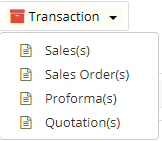
- There are numerous options like Sales, Sales Order, Proforma, Quotation which will open an independent grid in relation with the opened Enquiry.
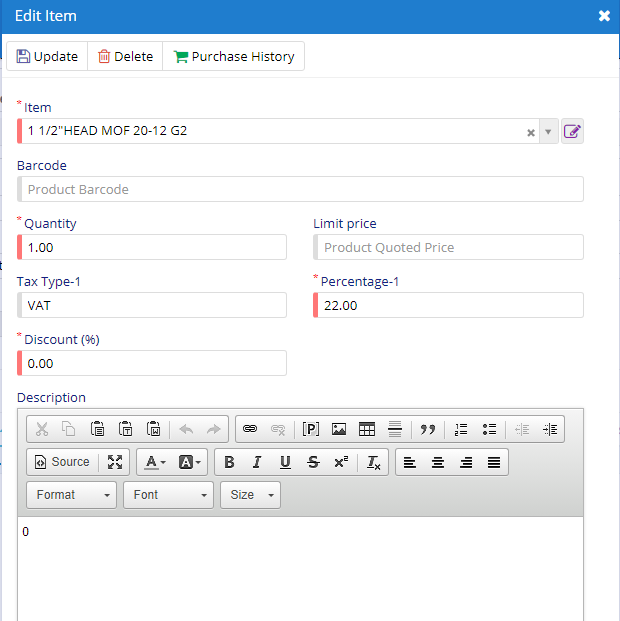
Enquiry is the first tab which will collect basic information such as contact’s name, date on which the enquiry was received and to which person it is assigned. This field will be read-only or hidden based on the type of permission assigned to the user. Apart from collecting the basic details, enquiries do contain field for selecting the product. On clicking the New Product button, you will be given the following dialog where you can select the product that was enquired.
Here, you can select the product which appeared in the Enquiry. Along with it you can also check with the Purchase History of the product by the clicking the button with the same name. Upon clicking, you will get the following Information box stating the details.

Lastly, you have a small Excel icon which denotes that you can upload the Product list using an Excel file to the current Enquiry. You can use this feature if you have many products to entered in this enquiry. Please note that Nafhaa Platform has restricted 500 records per Excel file to avoid congestion on the Nafhaa Platform as there are many other users and clients using the platform.

Additional tab deals with details which are essential wrt to tracking the Status, Stages in which the Enquiries are at the current instance. You can set the expected closing time of the Enquiry. Source fields denotes from which source the Enquiry was acquired. Using this field, you focus on Marketing as this field will give you a fair idea on which Source or Channel you need to focus to acquire more Enquiry and try to close it. The next two fields are Type and Win-Confidence which will help you to understand the Type of Enquires you receive and what are the probability of winning the Enquiry. You can also set the Branch field which will help you to bifurcate the Enquiries across branches. Additional Info is used to add details provided by the customer regarding the product(s). Similarly, an extension of this field is under Notes Tab as you can see below. There, you can multiple notes provided by the customer during discussion.

The next tab is for setting up Follow-ups with the current customer for the current Enquiry. You can set multiple follow-ups for the current Enquiry.


This how the follow-up dialog will look when you start adding it. As you can see in the image, we have Grid which will show you the number of follow-ups happened for the current Enquiry. Using the New Follow-up button, you can add new follow-up for the current Enquiry. On clicking the button, you will be given with a new dialog as shown above where you can set the Follow-up Note and the Details for the Follow-up along with the proposed Date and Time with the Status. When the Follow-up is done with the customer or client users are expected to update the Follow-up accordingly. For Automation of Follow-ups Enquires please check with the point above in Settings section.

Attachments tab will allow you to upload files or any other media which the customer has provided during communication.
DMS Tab will allow the user to add documents related to the Enquiry.

Here, can upload the file, assign Folder level under which it should be uploaded. If more bifurcation is needed, then, one can use DMS Division field. Description field can be used to describe the file in more informative way.
Under DMS, Sharing Tab will be used to share the document to the pears or users with validity specified.

As shown here, the user can select multiple users with whom the file is to be shared. Validity field will put restriction on visibility of the file until the specified date has been elapsed.
Under DMS, Linking Tab can be used to link the DMS to current record.

Using this, section, you can link the file which is uploaded to specific entry or record.
Requirement Tab

Requirement Tab will allow the user to collect the requirements specified by the customer for whom the enquiry entry is made. This tab will enabled only when respective settings are enabled.
BID Management
BID Management tab is useful for managing the BID that are done wrt to the records that are entered. This tab will visible only when the setting is enabled in respective module.

- BID Number will allow the user to specify the sequence number for the received BID.
- Reverse Auction Number will allow the user to specify the RA number which is generated.
- BID Start, End, Open and Quoted Date fields will allow the user to specify the required dates for the BIDs to process.
- BID Quoted Status, Financial Status Result fields will allow the user to specify thy status of Quote along with the Financial Status and finally with the results status for the BID. This will allow the user to manage the BID.
- L1 Price, Brand Quoted by L1 and L1 Name deals with the pricing, brand assigned to BID and finally, the name of L1 person or entity who is handling the details related details for L1 Biding.
- L2 Price, Brand Quoted by L2 and L2 Name deals with the pricing, brand assigned to BID and finally, the name of L2 person or entity who is handling the details related details for L2 Biding.
- BID Installation fields will allow the user to set the conditions or status of the BID.
- Inspection fields will allow the user to set the status of inspection if required.

The final section, deals with the EPBG, EMD and Tender Fees which is in continuation with BID Management.
- Export Performance Bank Guarantee (EPBG) field will allow the user to specify related amount and refund status.
- Ernest Money Deposit (EMD) field will allow the user to specify related amount and refund status.
- Tender Fees as the same is quite self explanatory and deals with fields where the user can specify the amount and refund status field.
Please note that Tab position or count may vary based on the settings and modules opted.
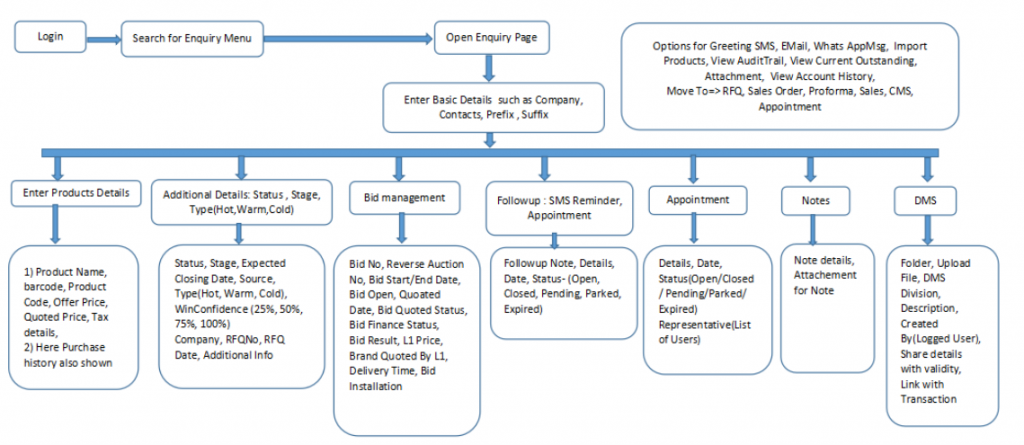
This sums up the Enquiry Module. We hope that you have fair bit of knowledge on how to use and handle the Enquiry Module. It is rightly said that, Practice makes man perfect which fits here correctly. As you keep on using this Module you will get used to it. If you find something is difficult to understand you can always connect with the Support team for help.